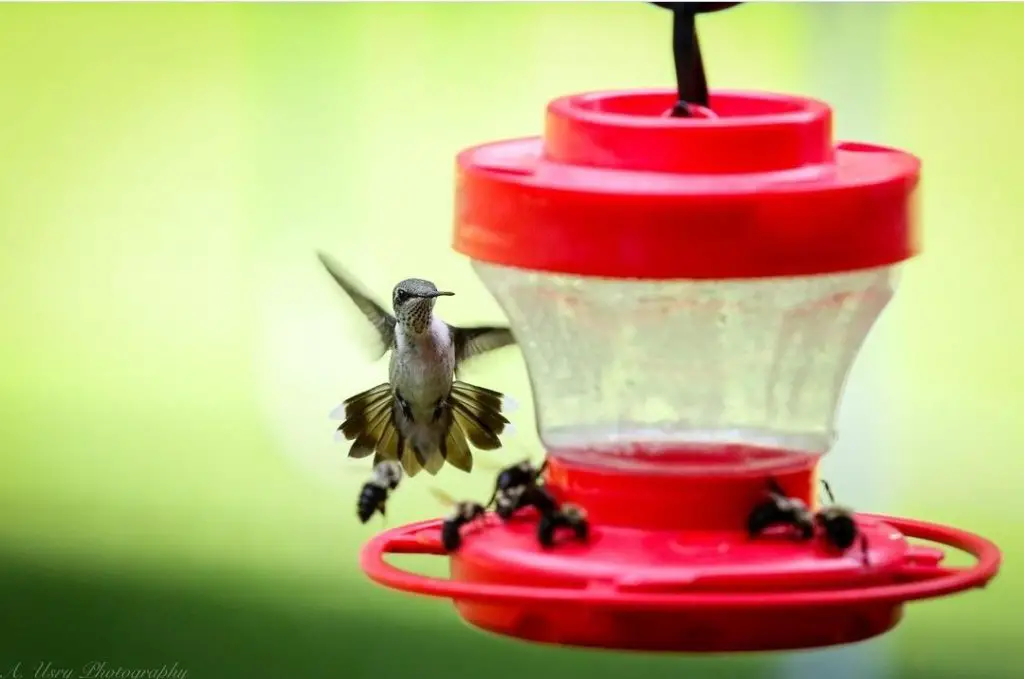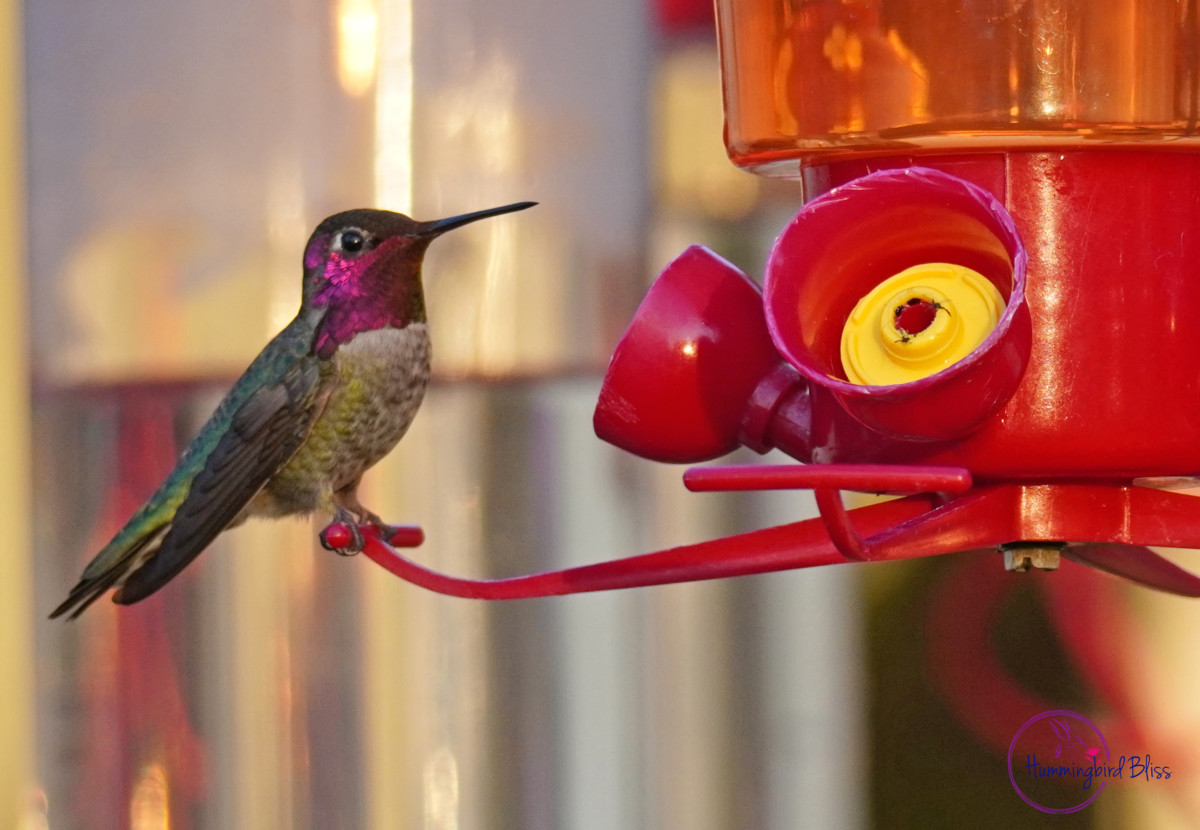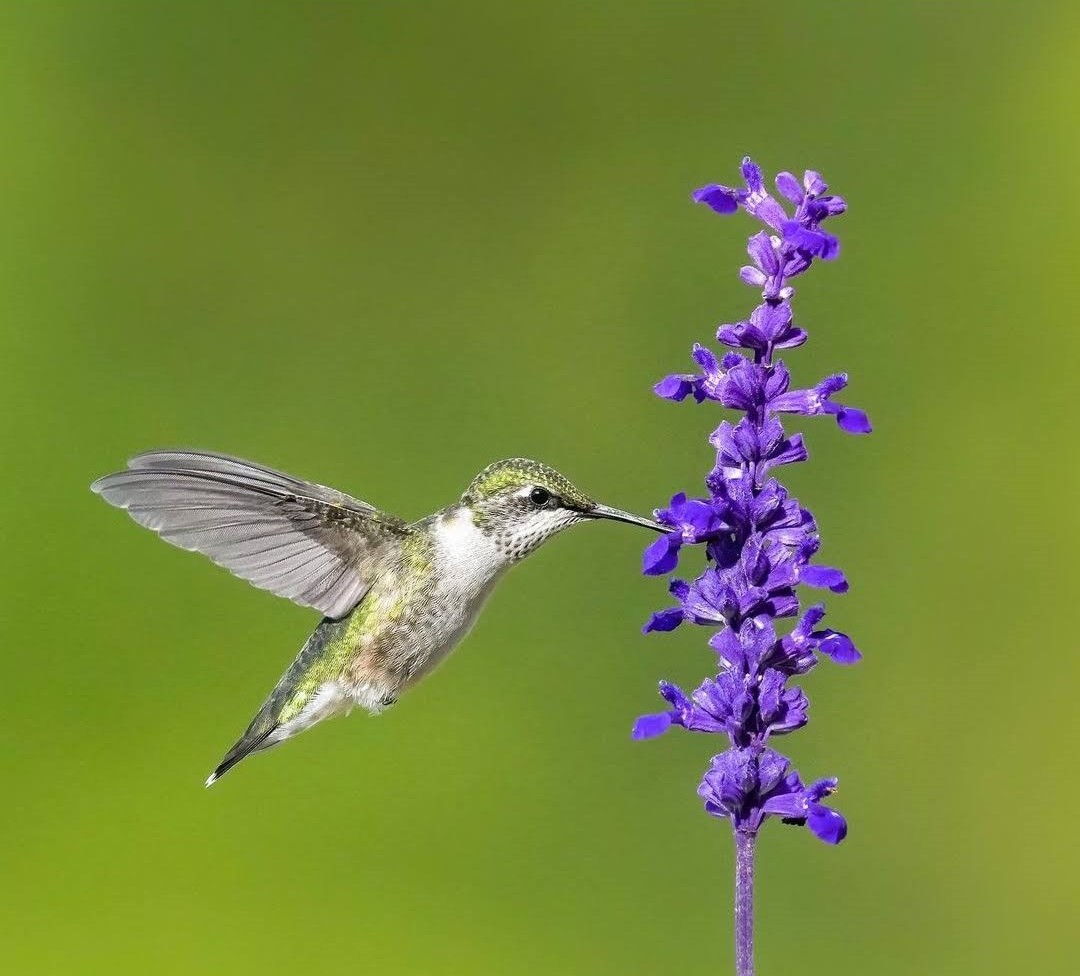This post contains affiliate links.
For years, everything I read about hummingbirds’ ability to smell told me hummingbirds could not smell. I found that strange since other bird species were known to have a sense of smell; why not hummingbirds?
Recent research has proven that this common myth that hummingbirds cannot smell has been debunked.
This article explains how and what hummingbirds are able to smell.
Can Hummingbirds Smell?
Hummingbirds have the ability to perceive scents and smell using their olfactory anatomical structures. Hummingbirds employ olfaction as a survival strategy to avoid potential threats while helping them find insects and nectar resources to consume.
Hummingbirds have long been thought to lack a sense of smell until recently. Contrary to popular opinion, hummingbirds actually have extremely sensitive olfactory abilities. This was demonstrated by recent research from the University of California, Riverside, where they conducted a thorough study that revealed that hummingbirds can detect scents. This has expanded our understanding of their foraging behaviors and ecological interactions.
Hummingbirds have olfactory bulbs, which are small structures found in the brain. These bulb-shaped structures are located at the base of the forebrain, are connected to the nasal cavity through a passage called the olfactory nerve, and are responsible for the ability to smell scents.
Since hummingbirds have small olfactory bulbs compared to those of vultures, which have large olfactory bulbs, scientists believed for a long time that hummingbirds could not smell.
Here is how the olfactory system works:
- Odor molecules from the environment are detected by specialized cells called olfactory receptor neurons in the nasal cavity. These neurons have receptors that bind to specific odor molecules.
- When odor molecules bind to the receptors on these neurons, they trigger a nerve signal.
- The neural signal is then transmitted along the olfactory nerve, which consists of bundles of axons from olfactory receptor neurons.
- The olfactory nerve carries these signals to the olfactory bulbs in the brain.
- In the olfactory bulbs, the signals are processed and integrated. Different odors activate specific patterns of neurons in the olfactory bulbs, allowing the brain to distinguish between various smells.
- From the olfactory bulbs, the processed information is sent to other regions of the brain, including the olfactory cortex, which further processes and interprets the smell.
Olfactory bulbs play a crucial role in the hummingbirds’ ability to perceive and identify different odors. The brain’s processing of olfactory information contributes to the sense of smell and can trigger emotional and memory responses associated with specific scents.
A comprehensive study conducted by UC Riverside researchers revealed the hummingbird’s ability to perceive scents, resulting in an expansion of our understanding of their foraging behaviors and ecological interactions.
The UC Riverside researchers conducted experiments, giving over 100 hummingbirds a choice between two feeders. One contained sugar water, and the other had sugar water with scents from other insects, with no visual differences between the two feeders.
The tests included aromas left behind by both honeybees and ants.
The aroma left behind on flowers by European honeybees was not a repellent for hummingbirds; however, the pheromones and defensive chemicals left behind by some ants were a strong repellant for the hummingbirds.

Scents left behind by honeybees do not bother hummingbirds. They are affected if the honeybees physically block the feeding ports.
Some ants left formic acid as a defensive chemical. The Argentine ant is the most prolific formic acid producer.
Formic acid is well known to be harmful to both birds and mammals.
What they found was that hummingbirds actively avoided feeders with scents from ants, particularly with formic acid. This indicates that hummingbirds are using their sense of smell to make foraging decisions to steer clear of potentially dangerous insects.
The researchers even did a test using a scent that’s completely foreign to nature, ethyl butyrate, which smells like Juicy Fruit gum. The hummingbirds did not seem to care about this new scent, proving that they were responding to the specific chemicals from the insects and not just avoiding new smells.
This discovery raises some intriguing questions about how important scent is in a bird’s foraging decisions, especially for hummingbirds
This newfound insight demonstrates that hummingbirds employ olfaction and do have a sense of smell as a survival strategy, avoiding potential threats while seeking nectar resources. Such revelations illuminate the intricate sensory adaptations of these remarkable avian species and contribute to their ecological roles within diverse ecosystems.
Can Hummingbirds Smell Sugar Water in a Feeder?
Hummingbirds can smell the sugar in the water of a hummingbird feeder. Hummingbirds can even determine the sugar concentration of the sugar water in the hummingbird feeder through their sense of smell.
Hummingbirds can smell the scent of various flowers; however, it is not the flower’s scent that attracts them. It is the ability to smell the sugar concentration in the nectar. It is the same for hummingbird feeders.
A hummingbird’s sense of smell plays a critical role in ensuring they get the nutrition needed to thrive. This ability is a vital part of their survival strategy, enabling them to find the optimal sugar concentration sources to sustain their high-energy metabolism.
Hummingbirds have a remarkable ability to detect sugar concentrations in feeders through their acute sense of smell and olfactory bulbs in the brain. They can sense even the smallest variations in sugar saturation.
Hummingbirds need a considerable amount of nectar to sustain their incredibly high metabolisms. When a hummingbird encounters sugar water in a feeder, their olfactory sensors pick up the scent of sugar concentration. This skill helps them identify the presence of suitable nectar in the feeder.
Sugar water in a hummingbird feeder needs to have the same concentration as the hummingbird’s favorite red tubular flowers. That ratio is one part sugar to four parts water (1:4).
For more information about feeder colors, see my article: Red Hummingbird Feeders: Essential or Optional.
They also rely on their sense of smell to find blossoms that have the highest amount of nectar. This helps them efficiently forage and feed to attain energy.
Although the flower’s scent is not the primary attractant feature, it may help identify the flower with the optimal sugar-to-water ratio in the flower’s nectar.
Can Hummingbirds Smell Flowers?
Hummingbirds can smell the scent of flowers, but the flower’s scent is not the primary attractant; it is the smell of the sugar in the nectar that attracts them. Hummingbirds can even smell the concentration of sugar in a flower’s nectar.
Hummingbirds can detect floral scents from flowers through their olfactory bulbs, the part of the brain responsible for smelling.
Scientists used to believe hummingbirds could not smell due to their small olfactory bulbs. However, as reported by the National Science Foundation, and the UC Riverside News, researchers from the University of California, Riverside, have discovered that even though hummingbird olfactory bulbs are small compared to those of other birds, hummingbirds can smell flowers. The USA’s National Science Foundation provided funding for this study.
The study showed through experiments involving various scents that hummingbirds can smell the difference between flowers and insects.
This study also showed that hummingbirds are not drawn to sweet scents, despite their ability to sense them; rather, hummingbirds were drawn to feeders and flowers because of their capacity to detect sugar content.
They not only use this sense of smell to find nectar but also to avoid potentially dangerous insects while foraging.
This discovery represents a significant contribution to our understanding of these remarkable birds’ sensory adaptations and their intricate foraging strategies.
Hummingbirds also use their hearing and color vision to help them find the most nectar-rich flowers.
The color of the flower helps the hummingbird find the most ideal sugar concentration, which is found in red flowers.
See my article: Red Hummingbird Feeders: Essential or Optional.
Hummingbirds also have excellent hearing and can detect the wind vibrations of a flower’s petals, helping them identify the most desirable nectar source.
Do Hummingbirds Find Insects by Smell?
Hummingbirds detect insects by smell, employing olfactory cues to recognize the presence and differentiation of a potential food source from a harmful insect competitor.
Hummingbirds are famous for their incredible visual abilities, which they primarily use to locate flowers filled with nectar. However, there is more to their food-seeking strategies than meets the eye.
Researchers have discovered that hummingbirds also rely on their sense of smell. New data shows and has been documented that olfactory sensory responses in the brains of both wild and captive hummingbirds play a significant role in optimizing their foraging efficiency to their advantage, especially when feeding on insects.
While visual cues are primary in their feeding strategy, their olfactory capacity plays a remarkable role in maximizing their foraging efficiency and reducing competition.
The University of California, Riverside, conducted a new study revealing that despite hummingbirds having significantly smaller olfactory bulbs in their brains compared to other bird species like vultures, hummingbirds have a good sense of smell, even targeting insects.
In these experiments, the researchers gave over 100 hummingbirds a choice between two feeders. One contained plain sugar water, while the other had sugar water with various scents signaling the presence of insects, with no visual differences between the two feeders in each test.
The researchers used scents like the one left behind after honeybees visit a flower vs. scents left behind by ants.
The results showed hummingbirds displaying no particular response to the scents of honeybees, which they commonly encounter around flowers. This lack of response suggests that they do not view honeybees as competitors for nectar resources, possibly because they can visually detect them easily.
However, when it came to certain ants, like Formica ants and Argentine ants, which can be a threat to hummingbirds at nectar sources, hummingbirds reacted differently. They avoided nectar feeders scented with the defensive chemical, formic acid, produced by these ants.
Birds are known to be harmed by formic acid, a defense chemical generated by some Formica ants.
This behavior indicates that hummingbirds can smell these chemicals to detect the presence of danger.
In the case of Argentine ants, hummingbirds also avoided feeders scented with these pheromones produced by the ants. This avoidance behavior helps reduce competition with ants for nectar.
Hummingbirds did not simply avoid any unfamiliar smell. When presented with a neutral, unfamiliar odor, they did not show any avoidance behavior, highlighting that their responses were specific to the scents of these particular insects.
The study highlighted the importance of scent in a hummingbird’s world and how it influences their food-finding strategies. Their sense of smell not only demonstrated the ability to detect the scent of insects but was also used to make foraging decisions and avoid harmful insects when seeking nectar.
Does the Smell of Vinegar Bother Hummingbirds?
The smell of white distilled vinegar does not bother hummingbirds.
Regularly cleaning hummingbird feeders using a solution of 1/4 cup vinegar to 1 quart water is recommended to prevent mold growth that can harm hummingbirds, especially in hot weather.
Distilled white vinegar is a natural and non-toxic cleaning product. The residual smell of vinegar does not bother hummingbirds, and it is completely safe to use when cleaning hummingbird feeders.
Cleaning and maintaining hummingbird feeders is essential to ensuring their overall health.
Do NOT clean your feeders with mild soap, as the soap residue is difficult to remove and could potentially harm hummingbirds.
A simple and effective way to clean hummingbird feeders using vinegar is:
Step 1:
Mix 1/4 cup of vinegar with 1 quart of water.
Step 2:
Detach the removable parts of the hummingbird feeder.
Step 3:
Soak the feeder parts in the vinegar and water solution, loosening any dirt, mold, or residue.
Step 4:
After soaking, use a brush or scrubber to gently clean the feeder thoroughly.
Scrub all the nooks, crannies, and feeding ports, especially those areas that are hard to reach with a toothpick.
Step 5:
Rinse the feeder and all its parts with clean warm water to remove all traces of vinegar and any remaining bacteria.
Step 6:
Allow the feeder to air dry completely (optional) before reassembling it and refilling it with fresh homemade nectar.
Follow these steps to keep hummingbird feeders clean and safe by preventing the growth of mold and harmful bacteria and ensuring a healthy environment.

Photo of a feeder in a yard with a lot of feeders!
See my article: What is the Black Stuff on my Hummingbird Feeder?
Cleaning hummingbird feeders and changing the sugar water every 3-5 days in cool weather, or every 1-2 days in hot summer days, will prevent fermentation and mold formation and maintain safe, fresh feeders for hummingbirds.
What Smells Do Hummingbirds Dislike?
Hummingbirds dislike the smell of formic acid produced by Formica ants and Argentine ants. They avoid scents resembling formic-acid-like odors, which can be harmful to them and may vary among individuals and species of hummingbirds.
A research study demonstrates hummingbirds are repelled by the smell of formic acid, a substance emitted by Formica ants and Argentine ants. This smell signifies a health threat to hummingbirds and indicates they can detect the presence of potential harmful competitors.
In the past, scientists believed that hummingbirds had no sense of smell whatsoever because they have relatively small olfactory bulbs in their brains. However, research from the University of California, Riverside, has discovered otherwise.
The olfactory bulb in the hummingbird’s brain gives them the ability to differentiate between pleasant and unpleasant smells.
This avoidance behavior indicates that hummingbirds use their sense of smell to make foraging decisions that help them steer clear of potential threats.
This newfound understanding of hummingbirds’ sense of smell to avoid danger adds another layer of complexity to these remarkable birds and their foraging behaviors, as well as how smell influences their daily decisions.
More research is needed to get a better understanding of how different scents affect hummingbirds. Current research has proved that they have a good sense of smell but is lacking information regarding a variety of scents and their effects on hummingbirds.
Check out my other posts on Hummingbird Questions
Happy Hummingbird Watching!
Backyard Visitors participates in affiliate programs which compensate us for referring traffic.


